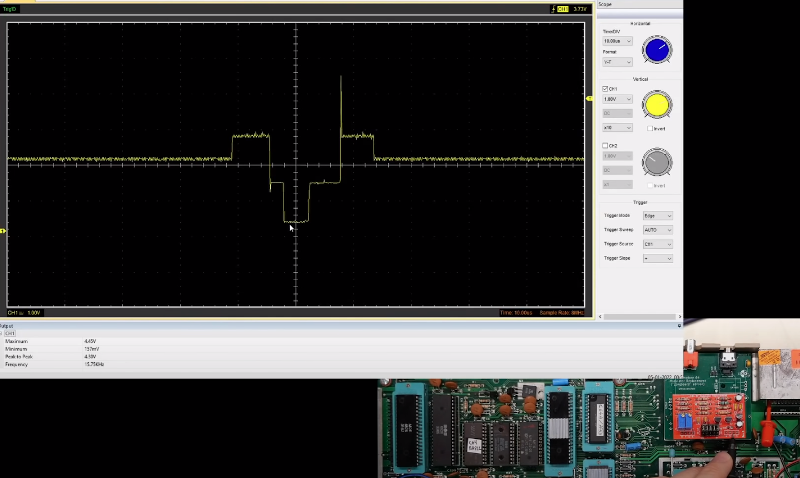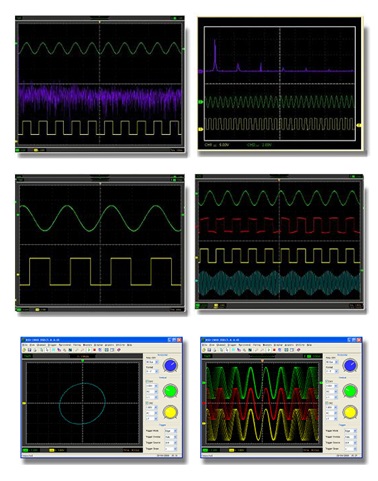
- Hantek 6022be software how to use driver#
- Hantek 6022be software how to use Pc#
- Hantek 6022be software how to use free#
It’s advertised as a 20 MHz scope, but that’s basically the Nyquist rate, so I thought it was marketing hype.
Hantek 6022be software how to use Pc#
Although the actual design might not need it, I will put space for such a series resistor on the PC board just in case. I put a 15Ω resistor between the complementary pair and the gate of the power MOSFET, and measured at the gate again: With a 15Ω series resistor on the gate of the power MOSFET, the ringing is mostly gone.

This is likely more representative of what the real circuit will do on a PC board.
Hantek 6022be software how to use driver#
The following trace was taken at the driver instead of the gate of the transistor: The ringing is not severe at the actual complementary pair output. Some of the ringing above is a consequence of my test setup, which has a foot-long wire going to the gate of the transistor, and a foot-long ground return. Below is a trace with the ringing dragged up where we can see it: The trace is moved up to show the ringing more clearly. To pan the trace right or left, I simply drag it, like a Google map. The trigger level can be adjusted in a similar manner. To move the channel 1 trace up and down, all I have to do is drag the yell ow “1” label up and down. The scope didn’t come with a manual, but I’m slowly figuring out how to use it. The transitions are quick, but that falling edge rings like the phone of a guy who just won the lottery. The next thing I tried was a complementary pair of small MOSFETS as a driver: Note that the incoming pulse had to be inverted in software. Okay, so I got rid of the resistor, and drove the MOSFET directly from the processor pin: Better, but I’m still not happy with the risetime. As a side note, observe the little nick in the rising waveform, marking the place where the transistor turns on and starts charging the Miller capacitance. Any time the transistor isn’t fully on or fully off, it’s wasting power. It’s like 4 μS for each transistion, which is horrible, considering this is only a 4.7 μS pulse. A train of positive-going pulses is input on the left No wonder the MOSFET was burning up! Look at that crappy rise and fall time. R5 is driven directly from a processor output pin. Below is the troublesome driver circuit for the main power MOSFET. This was a tough problem to diagnose without a scope, but is now trivial. My first use of this scope was to debug an overheating problem on a DC-DC converter circuit. There is also the handy feature of time, voltage, and frequency measurement by just dragging a cursor. It is, of course, a storage scope, and can send output directly to a printer, or save it in a variety of file formats, including bitmap and spreadsheet.

This model has most of the features of the analog scopes of yesteryear, including a built-in calibration source. For that paltry price, I got the scope, two probes that are settable for x1 or x10, and the software. Not since Adventures in Babysitting have I had such low expectations for something, and been so pleasantly surprised.
Hantek 6022be software how to use free#
I bought this instrument on eBay for $69.14, with free shipping. And by the way, the Hantek has no line cord – it draws all it needs from USB, though its PC connection. The line cord alone of an old analog oscilloscope might outweigh this tiny model. The Hantek 6022be digital oscilloscope weighs 13.3 ounces, and is a wonderful example of how technology gets cheaper and better with time. Two channel, 48 Msps digital scope weighs 13.3 ounces


Today, if I dropped this scope on my foot, I would be more worried about the scope than my foot. When I was in high school, if someone said they dropped an oscilloscope on their foot, it would be cause to go to the office for first aid, or possibly even call an ambulance.


 0 kommentar(er)
0 kommentar(er)
